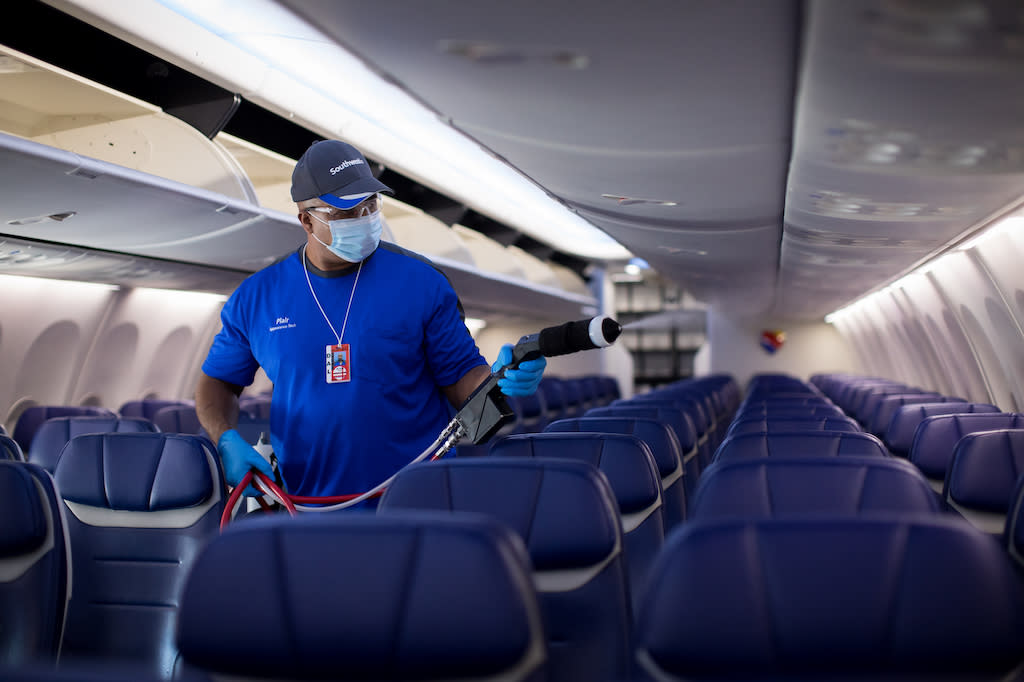A Mostly Domestic Southwest Airlines Is Seeing a Recovery Eluding Others for Now

Until early May, Southwest Airlines executives described their revenue stream as a leaky bucket, with some new bookings coming in, but not enough to offset losses from itinerary cancelations.
“You just can’t keep the water up,” Andrew Watterson, the airline’s chief commercial officer, said in an interview.
As many U.S. states, cities, and counties dropped stay-at-home orders earlier this month, Southwest began to see noticeable improvement, and on May 19, it reported new bookings outpaced cancelations for the first time since the Covid-19 pandemic hit the United States in March.
“It really marks the start of a recovery when you have it turned from net negative to net positive,” Watterson said.
Since then, Southwest executives have been more bullish than their counterparts at the three other large U.S. airlines, believing the travel rebound is here. As the Big Three move to slash staff and cut flights, Southwest is (mostly) staying the course.
Of course, Southwest has several advantages American Airlines, United Airlines, and Delta Air Lines do not. Southwest remains mostly domestic airline, and may capitalize if people travel closer to home later this year and into 2020. United, for example, derived 36 percent of its revenue in the fourth quarter of last year from international markets.
Southwest is also predominantly a leisure carrier, an important advantage as many companies cut travel, for economic or health reasons. In addition, Southwest does not rely on sales of pricey premium seats to juice its revenue, because it doesn’t have them.
“You do see domestic travel coming back earlier, and it skews toward leisure, or essential business, but not general business travel,” Watterson said. “Long-haul international seems to be not much at all and you expect that to take longer to recover. So if I was running a business where a third, to half, of the business was long-haul international, I would do things much differently than I do with Southwest Airlines.”
Strategy in Place
Perhaps customers would have returned anyway, but Southwest has worked to persuade consumers it’s time to travel.
Mostly, American, Delta and United have eschewed fare sales and promotions, perhaps betting it’s too early to entice non-essential travelers to return. Southwest had that strategy in March and April, as well, adopting what Watterson called hurricane-style pricing. Just as after natural disasters, Southwest mostly set flat prices, catering to people who needed to travel and didn’t need the cheapest fares.
But Southwest launched an ambitious one-month fare sale on May 12, combining it with a campaign to reward travelers with extra frequent flyer points. At the the same time, Southwest began advertising its new cleaning standards, while promising it would sell fewer seats to promote onboard distancing.
“The combination of that is what we were banking on, timed to happen with the shelter-in-place ending,” Watterson said. “That was what we were aiming for that and we believe it has worked as designed. But we’re still at extraordinarily low demand levels, I wouldn’t want to overstate things.”
Southwest is also flying with a lot of empty seats, because of the social distancing policy. That’s not a viable long-term solution, Watterson admitted, but for now, it gets people to book.
“To go back to the levels of prosperity airlines saw, you’d have to be able to sell the middle seat,” Watterson said. “But in a time when you have more supply than demand, it makes complete sense to fly capacity such that you can accommodate customers’ desire to have an empty middle seat.”
Still Softness
Some regions have bounced back quicker than others. Florida came back relatively early as many counties reopened beaches. But Hawaii essentially remains closed to tourists, so Southwest continues to operate just a token schedule. Even Las Vegas is not yet back, though demand may return soon, as hotels reopen.
Also, travelers in some regions are not booking as much vacation travel as others. Some large cities, including San Francisco and Los Angeles, remain under stay-at-home orders, while others have virus outbreaks or higher-than-average unemployment rates. In those places, bookings have not returned.
“There’s still more travel in May than in April, but it is reduced in a lot of geographies,” he said.
Schedule Update
In late May, Southwest extended its schedule through Jan. 4, and the airline’s domestic offerings look a lot like they would have without a global pandemic.
Southwest even is adding some service, with new nonstops from Phoenix, Las Vegas, Denver and Nashville.
The schedule suggests Southwest may be expecting a full recovery by year-end. That’s possible, but Watterson said the schedule is more of a best-case scenario. If flights do not sell, the airline will make adjustments.
If Southwest flies anything close to the published schedule, it may increase its market share as American, United and Delta shrink because of the crisis. It’s what happened after 9/11 and the 2008-09 financial recession.
“It’s a reasonable proposition that even if demand as an industry is not fully back, we can still have enough demand for Southwest to be the same size airline,” Watterson said.
Subscribe to Skift newsletters for essential news about the business of travel.

 Yahoo News
Yahoo News 
